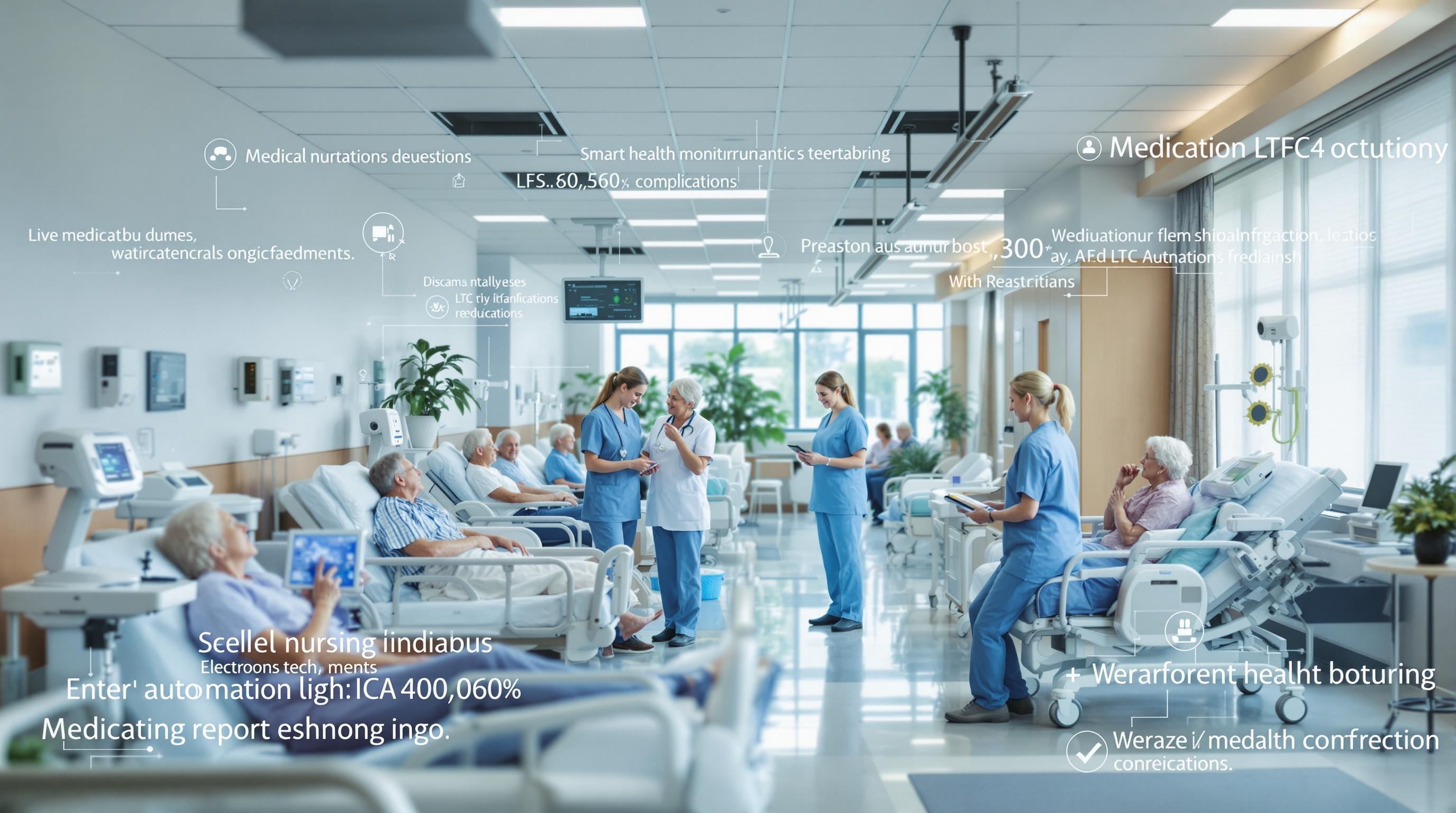LTC Automation: Transforming Skilled Nursing Facilities in 2024
Discover how LTC automation streamlines workflows, boosts care quality, and addresses staffing challenges in skilled nursing facilities.
Quick Navigation
- 1. Introduction
- 2. Current Challenges in LTC Automation
- 3. How Sparkco AI Transforms LTC Automation
- 4. Measurable Benefits and ROI
- 5. Implementation Best Practices
- 6. Real-World Examples
- 7. The Future of LTC Automation
- 8. Conclusion & Call to Action
1. Introduction
Did you know that by 2030, one in five Americans will be over the age of 65? As the population ages at a record pace, skilled nursing facilities (SNFs) are under immense pressure to deliver higher-quality care with fewer resources. According to recent industry insights, staffing shortages and rising operational costs are reaching critical levels, pushing long-term care (LTC) providers to seek innovative solutions just to keep pace with demand.
The COVID-19 pandemic only intensified these challenges, exposing vulnerabilities in traditional care models and accelerating the need for change. Enter LTC automation: a wave of emerging technologies designed to streamline workflows, support overburdened staff, and ultimately enhance resident outcomes. From automated medication management and digital documentation to smart scheduling and artificial intelligence, automation is quickly becoming a game-changer for skilled nursing facilities striving to do more with less.
But what does LTC automation really look like in practice, and how can SNFs navigate the opportunities—and obstacles—of integrating new technologies? In this article, we’ll explore the latest automation trends shaping long-term care in 2024 and beyond, examine how automation addresses staffing and quality concerns, and offer actionable insights for facility leaders considering the next steps in their digital transformation journey. Discover how embracing automation today can help your facility stay ahead in an ever-evolving healthcare landscape.
2. Current Challenges in LTC Automation
As long-term care (LTC) facilities embrace automation to streamline operations and improve care quality, they encounter a unique set of challenges. While LTC automation holds the promise of greater efficiency and accuracy, the implementation process is often fraught with obstacles that can impact operations, compliance, and patient care. Below are some of the most pressing pain points currently facing healthcare facilities in the realm of LTC automation:
-
1. Complex Revenue Cycle Management (RCM):
LTC facilities manage revenue cycles that are more intricate than those in acute care settings. Each patient’s stay can involve multiple payers, complex billing codes, and evolving care plans. According to Enter Health, even experienced professionals struggle to keep up with these details, and automation platforms must be highly adaptable to handle them. Automation that fails to account for these nuances can result in claim denials, delayed payments, and lost revenue.
-
2. Integration with Legacy Systems:
Many LTC facilities still rely on legacy electronic health record (EHR) and billing systems. Integrating new automation solutions with these outdated platforms is often costly and technically challenging. A 2023 survey found that over 65% of LTC facilities cited interoperability issues as a significant barrier to successful tech adoption.
-
3. Workforce Resistance and Training Gaps:
Staff in LTC settings are often resistant to new technologies due to lack of training or fear of job displacement. According to a 2022 LeadingAge report, 58% of LTC staff expressed concerns about automation increasing their workload or reducing job security, leading to slow adoption rates and underutilized systems.
-
4. Data Accuracy and Standardization:
Automation can only be as effective as the data it processes. Inconsistent or incomplete records remain a major challenge. The American Health Information Management Association (AHIMA) notes that data quality issues lead to billing errors in up to 30% of LTC claims, directly impacting reimbursement and compliance.
-
5. Compliance with Evolving Regulations:
LTC facilities must continuously adapt to new federal and state regulations, such as changes in Medicare and Medicaid requirements. Automated systems need constant updates to remain compliant, and lagging behind can result in costly penalties. The Centers for Medicare & Medicaid Services (CMS) issued over $300 million in fines to noncompliant LTC facilities in 2022 alone.
-
6. Upfront Costs and ROI Concerns:
The initial investment in LTC automation—hardware, software, and training—can be substantial. Many facilities, especially smaller ones, struggle to justify or absorb these costs without clear, short-term returns. 42% of LTC administrators in a recent survey reported cost as the top inhibitor to automation adoption.
-
7. Patient-Centered Care Risks:
Automation sometimes prioritizes efficiency over personalization, risking a decline in patient-centered care. Automated scheduling or medication dispensing must be carefully monitored to prevent errors or overlook individual needs.
These challenges underscore the need for thoughtful, phased approaches to LTC automation. Facilities must balance technological advancements with staff training, data management, and regulatory vigilance to maximize benefits while minimizing disruptions to care and compliance. For more insights on LTC revenue cycle management and automation challenges, visit Enter Health.
3. How Sparkco AI Transforms LTC Automation
Long-term care (LTC) facilities face mounting challenges, from chronic staffing shortages to manual workflow inefficiencies and the complex demands of regulatory compliance. Sparkco AI is redefining how LTC organizations approach automation, offering intelligent solutions that address these pain points head-on. By integrating advanced AI and automation, Sparkco AI streamlines daily operations, empowers staff, and improves resident outcomes—all while seamlessly fitting into existing systems.
-
Automated Staff Scheduling and Task Management
Staffing shortages are a persistent issue in LTC, often leaving teams overworked and residents underserved. Sparkco AI uses smart scheduling algorithms to automatically assign shifts, balance workloads, and alert managers to coverage gaps. This not only saves administrative time but also reduces burnout and turnover by ensuring fair, data-driven schedules that adapt to last-minute changes. -
Intelligent Medication and Inventory Tracking
Manual tracking of medication and supplies can lead to costly errors and compliance issues. Sparkco AI’s automated inventory management system keeps real-time tabs on pharmacy and supply levels, sends reorder alerts, and provides audit-ready reports. With AI-driven error detection, the system minimizes the risk of medication mistakes, supporting both resident safety and regulatory adherence. -
Effortless Documentation and Compliance Automation
LTC facilities must meet strict documentation and reporting standards, which can burden already stretched staff. Sparkco AI automates documentation workflows—capturing care activities, generating compliance-ready records, and flagging incomplete entries. By reducing paperwork, caregivers can spend less time at desks and more time with residents, while managers gain peace of mind knowing compliance is built in. -
Smart Communication and Alerts
Missed messages or delayed responses can compromise care. Sparkco AI integrates with existing communication platforms to automate notifications for critical events—like changes in resident condition, medication schedules, or supply shortages. The system routes messages to the right team members in real time, ensuring swift, coordinated responses and better resident outcomes. -
Data-Driven Insights for Continuous Improvement
Beyond automating tasks, Sparkco AI analyzes operational data to identify trends, inefficiencies, and opportunities for improvement. Facility leaders receive customized dashboards with actionable recommendations, helping them make informed decisions that enhance care quality and operational efficiency.
Seamless Integration for Hassle-Free Adoption
Sparkco AI is designed to work with the electronic health record (EHR), pharmacy, and communication systems already in use at most LTC facilities. With secure APIs and customizable connectors, implementation is quick and disruption is minimal—no need for a costly tech overhaul. This integration-first approach ensures that automation enhances, rather than complicates, existing workflows.
In summary, Sparkco AI addresses LTC automation challenges with a powerful suite of features that streamline operations, support staff, and improve resident care. By blending cutting-edge AI with practical integration, Sparkco AI empowers LTC organizations to thrive in an era of rising demands and limited resources.
4. Measurable Benefits and ROI
Skilled nursing facilities and long-term care (LTC) organizations face mounting pressures to control costs, reduce manual errors, and comply with evolving regulations. Implementing LTC automation technologies—ranging from electronic health records (EHRs) to automated billing and compliance tracking—can deliver significant, quantifiable benefits. Below are key metrics and case studies demonstrating the ROI and transformation possible with LTC automation.
-
1. Time Savings & Increased Productivity
Automating routine administrative tasks saves substantial staff time. According to a 2021 report by HealthIT.gov, EHR adoption in LTC settings reduced documentation time by up to 30%, allowing nurses to redirect 2-3 hours per shift to resident care. -
2. Cost Reduction
Automated billing and claims management can reduce administrative costs by 15-20%. A HIMSS case study found that one LTC facility saved over $100,000 annually by automating billing and reducing claim denials. -
3. Fewer Billing Errors & Faster Payments
Facilities leveraging automation reported a 60% reduction in billing errors and a 25% decrease in claim denial rates (Fierce Healthcare). This leads to faster reimbursement cycles—payments arrive up to two weeks sooner on average. -
4. Improved Regulatory Compliance
Automated compliance tracking enables LTC organizations to avoid costly penalties. Automated solutions can reduce compliance-related deficiencies by 40% (LeadingAge), and many report a 50% reduction in audit preparation time. -
5. Enhanced Resident Outcomes
Automated care planning and real-time alerts have shown a 20% reduction in medication errors and an 18% improvement in the timely administration of treatments (NIH). -
6. Labor Cost Optimization
Automation allows facilities to operate efficiently with leaner staffing. A study published in JMIR found that implementing automated scheduling and time tracking reduced overtime expenses by 25% and cut agency staffing costs by 18%. -
7. Data-Driven Decision Making
With real-time analytics, LTC facilities gain actionable insights into occupancy, care trends, and resource utilization. Facilities with advanced reporting tools reported a 12% increase in occupancy rates and a 15% improvement in care plan adherence (Health Catalyst). -
8. Reduced Paperwork and Storage Costs
Transitioning to digital records and automated document management can decrease paper consumption by over 80%, saving thousands in storage and material costs each year (HealthIT.gov).
In summary, LTC automation delivers substantial ROI through labor and cost savings, improved compliance, enhanced care quality, and smarter operational decision-making. These measurable benefits not only boost the bottom line but also strengthen quality of care and employee satisfaction.
5. Implementation Best Practices
Successfully implementing automation in Long-Term Care (LTC) facilities requires careful planning, regulatory awareness, and a commitment to change management. Automation can streamline processes, improve medication management, and enhance compliance—but only if executed thoughtfully. Below are seven actionable steps for an effective LTC automation rollout, along with practical tips, pitfalls to avoid, and change management guidance.
-
Conduct a Needs Assessment
Evaluate your facility’s workflows, pain points, and areas where automation could deliver the greatest value. Involve frontline staff for real-world insights.
Tip: Use surveys and process mapping to identify bottlenecks.
Pitfall: Avoid assuming “one size fits all” solutions; tailor automation to your unique LTC environment. -
Align with Regulatory Requirements
Ensure that automation tools comply with federal (CMS, HIPAA) and state regulations, including documentation standards and survey readiness.
Tip: Consult the CMS Long Term Care Regulations and involve compliance officers early.
Pitfall: Don’t overlook evolving surveyor guidance—regulations can change annually. -
Choose the Right Technology Partner
Select vendors with proven LTC experience, robust training resources, and responsive support.
Tip: Ask for case studies and check references from other LTC facilities.
Pitfall: Avoid vendors with generic healthcare solutions lacking LTC-specific features. -
Develop a Detailed Implementation Plan
Map out timelines, milestones, and responsible parties. Include contingency plans for unexpected challenges.
Tip: Pilot automation in a single department before facility-wide rollout.
Pitfall: Don’t skip user acceptance testing—early feedback is critical. -
Invest in Staff Training and Engagement
Provide hands-on training tailored to different staff roles. Address concerns and highlight the benefits of automation.
Tip: Use “super users” or champions to support peers during transition.
Pitfall: Avoid a top-down approach—engage staff at all levels for buy-in. -
Monitor Performance & Solicit Feedback
Track key performance indicators (KPIs) such as error rates, time savings, and compliance metrics. Regularly solicit feedback from staff and residents.
Tip: Schedule post-implementation reviews at 30, 60, and 90 days.
Pitfall: Don’t ignore ongoing challenges—continuous improvement is essential. -
Plan for Scalability and Future Integration
Choose automation solutions that can grow with your facility and integrate with EHRs, pharmacy, and billing systems.
Tip: Document lessons learned for future phases or locations.
Pitfall: Avoid siloed systems that can’t communicate with other healthcare technology.
Change Management Considerations: Transparent communication, strong leadership, and ongoing support are vital for staff adoption. Address resistance by involving staff early










